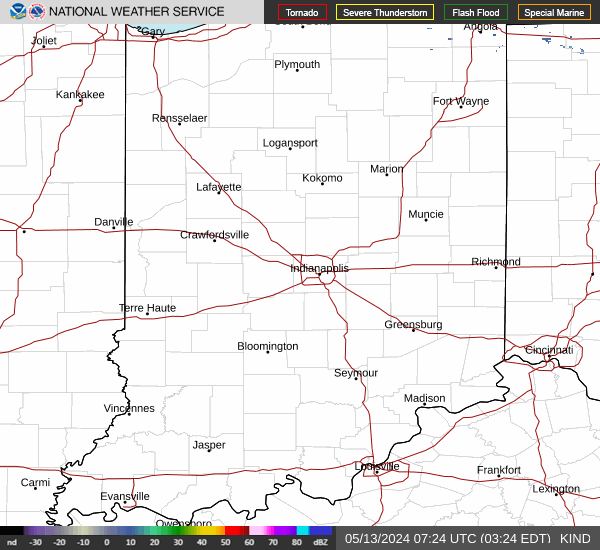Thunderstorms — some possibly severe with damaging winds — will sweep across Central Indiana early this week followed by the potential for dangerous heat, according to local meteorologists with theNational Weather Service, who advise Hoosiers to pay careful attention to the weather.
By Thursday, forecasters say rainy conditions will give way to peak afternoon heat indices that could reach 102 in Indianapolis and 106 in Bloomington. Meanwhile, Terre Haute and Vincennes could see temperatures with heat indices around 105, NWS said.
Here's what we know.
NWS issues special weather statement for July 30 - Aug 1, 2024
NWS issued a special weather statement Tuesday urging Hoosiers to plan ahead by limiting outdoor activities.
"Peak afternoon heat index values will approach or exceed 100 degrees across portions of central Indiana today through Thursday, though uncertainty exists due to potential for storms," Meteorologists with NWS said Tuesday on social media.
Heat indices could climb to 105-degree range, per NWS
"We're expecting a few more rounds of thunderstorms over the course of the week and then things really start to heat up when we get to Wednesday and Thursday," said Andrew White, a meteorologist with the NWS in Central Indiana.
White told IndyStar multiple rounds of thunderstorms near Vincennes will likely push northwest, then heat indices could get into the 105-degree range toward the end of the week. He advised Hoosiers to stay in contact with friends and family who might be particularly vulnerable to hotter weather.
"With the heat coming up, it's a good time to check in on your neighbors, especially those who may be more sensitive to it," White said. "Stay inside and drink plenty of water."
What are the symptoms of heat exhaustion?
Symptoms of heat exhaustion include the following signs:
- Dizziness orfainting
- Excessive sweating
- Cool, pale and clammy skin
- Nausea or vomiting
- Rapid, weak pulse
- Muscle cramps
Experts say if you or someone else is experiencing heat exhaustion to drink cool water, seekair-conditioning, takea cool shower or usea cold compress to alleviate symptoms.

Staying cool:Your window fan is facing the wrong direction. Or not. Here's how to tell and save money.
Live weather radar for Central Indiana

Weather forecast for Central Indiana, per NWS
☁️ Tuesday: Patchy fog before 9 a.m. Otherwise, mostly cloudy, then gradually becoming sunny, with a high near 89. West wind 3 to 7 mph.
🌜 Tuesday night: Scattered showers and thunderstorms, mainly after 2 a.m. Partly cloudy, with a low around 71. South southwest wind 3 to 5 mph. Chance of precipitation is 30%.
⛈️ Wednesday: Scattered showers and thunderstorms. Mostly sunny, with a high near 89. South southwest wind 5 to 8 mph. Chance of precipitation is 50%. New rainfall amounts between a tenth and quarter of an inch, except higher amounts possible in thunderstorms.
☁️ Wednesday night: A 40 percent chance of showers and thunderstorms. Partly cloudy, with a low around 73. South southwest wind around 6 mph.
⛈️ Thursday: A 50 percent chance of showers and thunderstorms. Mostly sunny and hot, with a high near 92. South southwest wind 6 to 10 mph. New rainfall amounts between a tenth and a quarter of an inch, except higher amounts possible in thunderstorms.
⛈️ Thursday night: Showers and thunderstorms likely before 2 a.m., then showers likely and possibly a thunderstorm after 2 a.m. Mostly cloudy, with a low around 72. West southwest wind 5 to 7 mph. Chance of precipitation is 70%. New rainfall amounts between a quarter and half of an inch possible.
🌤️ Friday: A chance of showers and thunderstorms, then showers likely and possibly a thunderstorm after 2 p.m. Partly sunny, with a high near 85. West wind 6 to 9 mph. Chance of precipitation is 70%.
⛈️ Friday night: Showers likely and possibly a thunderstorm before 8 p.m., then a slight chance of showers and thunderstorms between 8 p.m. and 2 a.m. Partly cloudy, with a low around 68. Northwest wind 5 to 7 mph. Chance of precipitation is 60%.
🌤️ Saturday: A 30 percent chance of showers and thunderstorms, mainly after 2 p.m. Mostly sunny, with a high near 85. North wind 6 to 8 mph.
🌜 Saturday night: A 30 percent chance of showers before 8 p.m. Mostly clear, with a low around 67. North wind 3 to 7 mph.
☀️ Sunday: Sunny, with a high near 87.
🌜 Sunday night: Mostly clear, with a low around 65.
How to stay safe during hot weather
Older Hoosiers and young children, experts warn, are the most at risk during periods of extreme heat. Here's what they recommend doing to stay safe:
- Stay hydrated and avoid sugary, caffeinated and alcoholic drinks.
- Electric fans may not provide relief, instead take a cooling shower or bath and find an air-conditioned space.
- Reduce, eliminate or reschedule strenuous outdoor activities.
- Eat light, cool, easy-to-digest foods like fruits or salad.
Centers for Disease Control and Prevention
- Choose lightweight, loose-fitting clothes.
- Head to a public library or other space with air conditioning.
USS Indianapolis:A disaster turns 79. Sinking of Navy ship leads to world's worst shark attack
John Tuftscovers trending news for IndyStar and Midwest Connect. Send him a news tip atJTufts@Gannett.com. Follow him on Twitter atJTuftsReports.